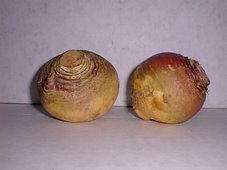 Vexing technical problems continue to hamper efforts to increase the appeal and marketability of the rutabaga. As every recipe demonstrates, the extreme macromolecular densities and mass of the rutabaga guarantee excessive and impractical cooking times for all but the most dedicated rutabagans. However, ARSI's laboratories have taken an innovative look at the problem, resulting in several potential solutions:
Vexing technical problems continue to hamper efforts to increase the appeal and marketability of the rutabaga. As every recipe demonstrates, the extreme macromolecular densities and mass of the rutabaga guarantee excessive and impractical cooking times for all but the most dedicated rutabagans. However, ARSI's laboratories have taken an innovative look at the problem, resulting in several potential solutions:
- A 24,000-watt microwave oven may reduce cooking times to 96 hours for a 2-pound rutabaga;
- An ionic oven, under development at CalTech, could reduce baking time to 16.8 hours;
- Trial "cooking" sessions using the neutron accelerator at Karnac, Illinois, have miraculously reduced cooking times to 8.4 hours.
The latter method, while most efficient, consumes vast amounts of electricity and can produce catastrophic submolecular degradation [i.e., an explosion] if slight "overcooking" occurs. It therefore seems unlikely to produce a short-term solution.
Extended cooking times are only one of many factors which inhibit consumer acceptance of the rutabaga. ARSI studies have shown that cooking times can be reduced (up to 25%) by cutting rutabagas into very small pieces. However, the extreme hardness of the product renders the process of slicing and dicing very laborious and frustrating. With this in mind, ARSI continues its laboratory trials with industrial-grade wood chippers, whose conventional grinding gears are worn out far too quickly to provide a practical means of preparing rutabagas for cooking. A stainless-steel gear with diamond-studded teeth and a titanium core has been fairly effective, but the cost remains prohibitively high. Researchers are now evaluating miniaturized versions of Boreregard, the rock boring machine recently used to construct a light-rail tunnel in OregonPHOTO: A modified Hiroller 1250 wood chipper with diamond-studded teeth and a titanium core, approved by ARSI in 2006 for use in cutting rutabagas. A much smaller and more economical version, suitable for use in kitchens, is currently under development.





2 comments:
I'm a first time rutabager. I've been afraid to start on the thing, so I turned to the internet. I find it very comforting, but it still may take a while for me to get started. More research on cutting is needed. Although, my friend successfully cuts it with a high powered electric knife.
thanks,
Hammer and knife: a very fast cutting method. Use a hammer to whack a thick, wide knife to half the rutabaga (for thinner kifes, you'll need to whack the sides down.)
Place halves flat side down, and whack out slices; this is quick and simple. Use a paring knife to remove the skin, and whack into cubes if so desired.
Simmer in shallow amount of plain water, which will be a special, sweet juice to drink, or use in recipes.
Or, eat it raw. The pieces are a long lasting, sweet, fat-free treat that can be enjoyed without guilt.
Post a Comment